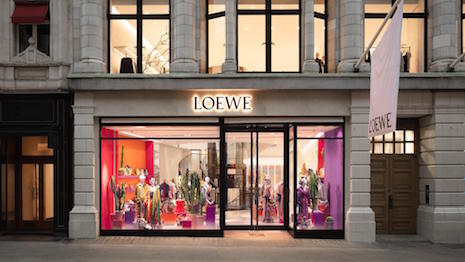- About
- Subscribe Now
- New York,
May 21, 2019

 Loewe leans into growth with new home. Image credit: Loewe
Loewe leans into growth with new home. Image credit: Loewe
MADRID – As luxury consumers and the business itself continue to change, these rapid developments pose a challenge to brands with decades of storied history.
Loewe creative director Jonathan Anderson discussed the evolution of luxury in a conversation with the Financial Times’ fashion editor Jo Ellison at the FT Business of Luxury Summit on May 20. After being named creative director of Loewe in 2013, Mr. Anderson was tasked with protecting the Spanish house’s heritage while modernizing its image.
“When I first started [as creative director], my predecessor had gone down a nostalgic route with the heritage [of craftsmanship],” Mr. Anderson said. “For me, there was a disconnect in the reality of making [the goods].”
Loewe legacy
The Spanish apparel and accessories house was founded in 1846, and is LVMH’s oldest luxury fashion brand.
“The craftsmanship and authenticity was right there,” Mr. Anderson said.
Loewe's Elephant Bag modeled by Doutzen Kroes. Image courtesy of Loewe
Perhaps best known for its luxury leather goods. Loewe also sells high-end ready-to-wear apparel and homewares.
Among Mr. Anderson’s accomplishments at Loewe is leaning into women's wear.
“It needed to resonate with what we do, it can’t be polarizing,” Mr. Anderson said. “How do we bring craft into the modern world? How do you build a cultural brand today?”
Retail priorities have also shifted at Loewe, with an emphasis on artisanship in exhibits and bricks-and-mortar stores.
For its fifth Salone del Mobile, Loewe put a new perspective on weaving in an art project that replaced traditional plant-based materials with leather and textiles. The house tasked 11 artists with transitioning their techniques from bamboo or straw into baskets or sculptures fashioned of leather (see story).
The brand also recently opened a new boutique in London in a heritage space.
Aptly named Casa Loewe, the new location is meant to create the feeling of stepping into a collector’s home. Many pieces will rotate in and out, including installations, to keep Loewe’s focus fresh (see story).
Mr. Anderson also noted the importance of engaging with local people and the cities around Loewe’s new stores. Many consumers are now driven by both engagement and instant gratification.
Loewe teamed up with Paula's for its latest collection and pop-up shop. Image credit: Loewe
Customer loyalty poses a challenge for Loewe and other luxury brands, according to Mr. Anderson, as consumers want to protect their individuality. This is a notable difference from even a couple decades ago.
“Luxury was not an inclusive thing,” Mr. Anderson said about his experiences growing up. “It was a barrier.”
Modern designers
In addition to his responsibilities at Loewe, Mr. Anderson has his own menswear label, JW Anderson, through which he is able to explore his more experimental inclinations.
“At Loewe, it is not my name above the door,” he explained. “It’s more about protection.”
Mr. Anderson also spoke about the changing role of the luxury designer.
“There are huge obligations in being open, accessible, being able to talk to people,” Mr. Anderson said. “You have so many responsibilities. You have to be able to empower teams.”
Mr. Anderson also cited Karl Lagerfeld, the late creative director of Chanel and Fendi, as the last luxury designer in a classical sense.
Mr. Lagerfeld held the simultaneous roles of creator and fashion personality, becoming a household name to those beyond the industry thanks to his signature look and sometimes outspoken nature. From reviving Chanel to blockbuster brand status to modernizing fur at Fendi, Mr. Lagerfeld was a rare talent in his ability to steer multiple houses in different directions at the same time (see story).
However, Mr. Anderson does not foresee his own fashion career as having similar longevity.
“Fashion for me is about trends,” Mr. Anderson said. “There’s going to come a point where my imagination has exhausted itself.
“I have to step away for the next generation,” he said.
Share your thoughts. Click here